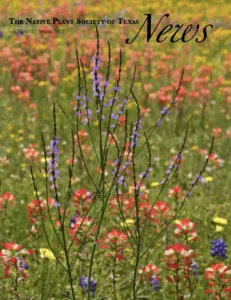Latest Issues

Fall 2025 Member Magazine
President’s Message | Executive Update | Celebrating Leadership | Curb Appeal with a Cause | Grant Recipients | Autumn’s Perfect Pairing | Native Plant Database | Sustainable Landscaping | Winterizing Tips

Summer 2025 Member Magazine
Executive Summary | Resilience in Bloom | Suburban Sanctuary | Texas-tough Summer Survivors | Where Salsa Meets Sage | A Rain Garden Grows | Member News | Smart Watering

Spring 2025 Member Magazine
Executive Summary | Blooming with Possibility | Wildflower Waltz | Native Grasses | Member News | Texas Wildflower Day
Distribution
- Texas Native Plants is published quarterly and the digital version is distributed free to all Society members in current standing.
- The digital version is also available in our library below.
- Print versions are mailed at no cost to Society members in current standing who select to receive a print copy when they join/renew.
- Libraries, educational institutions and other organizations may qualify to receive the publication for a $5 annual fee.
- Contact the membership coordinator.
- Many of our chapters publish their own newsletters and websites.
- These have their own deadlines and guidelines. See list of chapters.
History
Since its founding the Society has provided a news periodical to its members. there have been a variety of names and formats. The Texas Wildfower Newsletter edited by Carroll Abbott served as the first newsletter. He advocated the formation of the Native Plant Society of Texas in his quarterly publication Texas Wildflower Newsletter. After the Society was created in 1980, a free subscription to Abbott’s newsletter was provided as a benefit to all members. His declining health eventually prompted Abbott to request that the Society start its own newsletter. Lean more about the Carroll Abbott story.
Beginning in 1983 our own official publication has documented the evolution of the native plant movement and the Native Plant Society of Texas. The publication has had several slightly different names and formats over the years. By 2005 it had evolved into a full-color glossy magazine.
Editorial Submissions
The Native Plant Society of Texas encourages submission of articles, photos, pertinent news or other interesting information for publication.
- Submit articles or written items as email attachments.
- Send photos as email attachments in JPG, RAW or TIFF format.
- Larger file size and best quality are preferable.
- Contact the Editor for more information.
We reserve the right to edit all submissions for accuracy, relevance, length, grammar or for other reason. In matters of style our print publication generally follows the Chicago Manual of Style.
Unless prior arrangements with the editor are made, submissions may also appear on our website and linked on our social media pages. We do not accept outside advertising in any of our publications.
Publications Library
Click below to view issues by year/editor. Or visit our online archive.
2015 – Fall
- Anouncing Board Nominees
- Among Natives and Exotics in San Antonio
- Texas Native Plant Week
- Youth Outreach
2015 – Summer
- Using Biomicmicry in Landscape Design
- The “Magic Words” to Use with HOAs
- More than Milkweeds: A Panhandle Perspective
- Scholarship Recpients
2015 – Spring
- Fall Symposium Call For Papers
- Remembering Kate Hillhouse
- Wetlands’ Role In Our Native Landscape
- Water Gardening At Home
2015 – Winter
- Success In the Four Corners: Symposium In Review
- Revisiting Tobusch Fishhook Cactus
- Can a Native Plant Be Noxious or Invasive
- Chapter Tool Chest: Aids to Chapter Success
2014 – Fall
- 2014 Symposium
- On the Road (Again) With Carroll Abbott
- Scholarship and Grants For Students
- Chapters in Focus: San Antonio & Lindheimer
2014 – Summer
- Rejuvenated Spring Symposium
- Benny J. Simpson Fellows Nominees
- Seed Banking Texas Ash Species
- Lawther Deer Park Prairie
2014 – Spring
- Tribute to Carroll Abbott
- Spring Symposium: Keynote by Dr Tallamy
- Enchanting Spring Ephemerals: Trout Lily
- Eye on Education
2014 – Winter
- Postcards form Corpus Christi
- Gulf Fritillary and Passionflower
- Native Bees
- Membership Contest
2013 – Fall
- How a purple thistle taught children ecology
- An appreciation of winter’s strip show
2013 – Summer
- The A.E. Leonard Native Plant Garden
- A Trip to Big Bend
- Anisacanthus
- Fragrant Mimosa
2013 – Spring
- Reintroduction of Horned Toads
- Little Bluestem
- Serendipity of native “Symphs”
- Buttonbush
2013 – Winter
- Let’s bring the Monarchs back to Texas
- Believe the leaves (usually)
- Celebrating 30 years of newsletters
- Snailseed vine
- Post wildfire regeneration in Bastrop State Park
2012 – Fall
- Andy Wasowski dies
- Some favorite cacti
- Design techniques for natural landscapes
2012 – Summer
- Yellow peril!
- Native bees in Texas
- Rain barrels
2012 – Spring
- Attracting monarchs
- Some native milkweeds
- Romancing the Land
- Healing hands help heal the land
2012 – Winter
- Rising from the ashes – Bastrop State Park
- Mexican plum
- Comanche Peak Prairie Clover
- Think like a plant
2011 – Fall
- Desert Willow
- A society of garden clubs – Not!
- Toothleaf goldeneye
- Why hire an executive director?
2011 – Summer
- Lantana urticoides
- Citizen scientists make a difference
- Going native in Lufkin
2011 – Spring
- Phlox pilosa
- Tribute to Bill Ward
- George W Bush Library






















